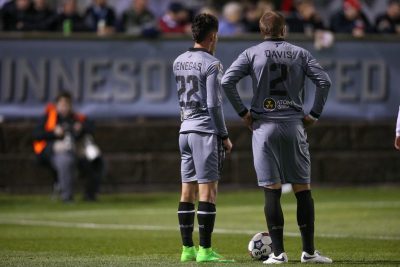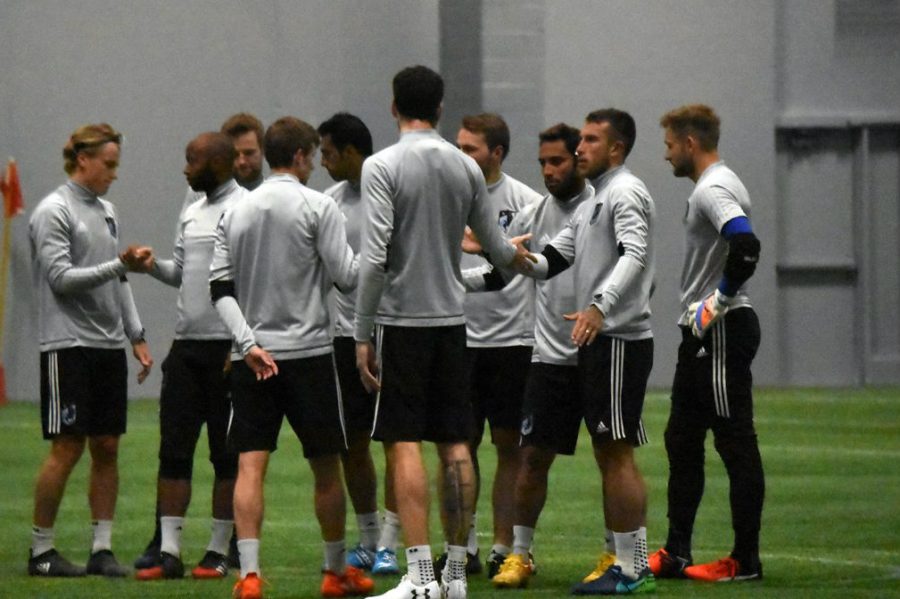With Minnesota United’s roster close to complete, it’s time to look at what the on-field product will be. There are many buzzwords thrown around when analyzing club rosters. One of these, inevitably, is “depth.” Using United’s roster as a case study, we’re able to look at what depth really is.
Four months ago, Minnesota United as an MLS club was basically a concept.
The club had worked to secure their strong “United” branding. There would be many holdovers in the front office ranks, giving the organization time to gel. However, the on-field product would inevitably become the face of the expansion side.
Last week, I looked at five major storylines surrounding the current roster as the Loons build towards their season opener. These ran across the pitch, from lineup options to tactical plans. Ultimately, one word is applicable to many of these questions: depth.
Given recent acquisitions and a couple of potential ones, questions of depth become the main narrative. For the expansion side in Minnesota, it could make or break their opening season’s results.
Case study one: the attack
On Wednesday, Minnesota United announced the acquisition of Bashkim Kadrii. The attacker was first linked to Minnesota in late January. Coming to the club on a loan from FC Copenhagen. Kadrii is a very versatile player and can play on either wing, as a striker, or as an attacking midfielder. The 25-year-old Dane is an aggressive player on the ball and is a tireless runner.
Two weeks prior, United traded for Kevin Molino. Similarly, Molino is able to thrive in multiple positions, most prominently out on the right or as a No. 10. This is the same for Costa Rican attacker Johan Venegas, who can play either as a second striker or on the wing. Meanwhile, returning star Miguel Ibarra can also be deployed out wide or centrally.
All things considered, all four of these players are best described as “attackers”. None of the quartet have a rock-solid position and all four are worthy of earning regular minutes.
This is far from a problem. In fact, it’s something that most clubs in MLS pine after. All told, it gives head coach Adrian Heath a healthy pool to choose from. In this case, depth isn’t a matter of “starters” and “backups” in a classical sense. Instead, it’s four players looking at three spots every week. The internal competition is only a positive for the club.
The same goes, by the way, for the pool up top. Christian Ramirez seems to be the front-runner to start at striker. However, the club used a valuable first-overall SuperDraft pick on Abu Danladi. While Danladi can play on the wing, Heath sees the former UCLA man as a striker. The two players can push each other to train harder and, ultimately, score more often. Meanwhile, young Femi Hollinger-Janzen scored two goals and added one assist in 273 minutes with New England. He’ll be hungry to build on that time entry.
Case study two: center back
One of the first parts of the lineup to take shape was United’s center back pairing. In late December, Minnesota signed Costa Rican international Francisco Calvo. Two weeks later, the Loons brought in Norwegian international Vadim Demidov. On paper, the two should play well alongside one another. Calvo is a quick player with the ability to score goals and harass opposing attackers outside the box. As a complement, Demidov is a no-nonsense defender who muscles the opposition away from the ball.
For more on Calvo’s signing as a sign of Minnesota’s ambition, click here.
Behind the two, there’s considerable depth of which to speak. The club’s first external acquisition was Joseph Greenspan, brought in from Colorado. Greenspan is a smart, strong player, though he missed most of his first two years due to Navy duty. Then, Minnesota brought back Brent Kallman. A regular starter in 2016, Kallman is a very capable athlete who turned in an NASL Best XI-worthy campaign.
In a move that flew under the radar, the club secured MLS veteran Jermaine Taylor. The Jamaican international has made 122 starts across six seasons in the league. Prominently, he served as a major part of Houston’s back-to-back MLS Cup appearances in 2011 and 2012. His move may be absolutely vital, but we’ll cover that after the next jump.
Finally, the Loons have another holdover center back joining them in Portland. Tiago Calvano joined United in 2014, after a nomadic career with stops in Brazil, Spain, Germany, and Australia. He appeared in 71 matches over the last three seasons and served as the club’s vice-captain in 2016. FiftyFive.One has learned that Calvano had a contract option for 2017 negotiated into his last deal. As it stands, he’ll be paid by the club whether they sign him or not. If they do bring him aboard, he’ll join an incredibly deep pool of defenders.
Case study three: full back
It’s nearly impossible to write about Justin Davis or Kevin Venegas without mentioning them both. The two were possibly Minnesota’s biggest advantage compared to other NASL sides. No other team could boast a pair of full backs that were such capable attackers while showing defensive prowess. Naturally, the two were announced within minutes of each other as the first players signed to MLS contracts in the club’s history.

Before looking ahead, it’s fair to assess a problematic trend during the NASL era. In 2016 alone, Davis missed one match on a red card. In that match, United was torched at home by Tampa Bay, with a Joe Cole header (you read that correctly) serving as the exclamation point. Meanwhile, Venegas suffered an injury to his left knee in a summer friendly against AFC Bournemouth. He missed most of the remaining campaign. Without Venegas, the club sputtered through the Fall Season, ultimately missing the postseason.
In both cases, the club didn’t have a natural backup ready to take over. In the Tampa Bay match, Kallman made his left back debut before being subbed off at halftime. Meanwhile, the Loons tried center back Damion Lowe at right back for three matches. When that failed, they relied on Jeb Brovsky, weakening the central midfield as a result.
It is imperative that the club signs at least one backup full back before March. Taylor has seen time at both positions and figures to play a role to that end. Whether you believe Davis and Venegas are MLS starters or not, Minnesota fans have seen the club burnt by a lack of options in the past. This year, the two will need to find their feet quickly in a new league. At this point, there’s no alternative.
What’s the point?
All across the field, it’s better to have too many options than too few. While that may seem straight forward, it’s easy to forget how important depth is to success in this league.
Going into any season, there are clubs with plenty of buzz due to a strong starting lineup. Every year, the Los Angeles Galaxy seem to be that club. However, injuries to key players like Robbie Keane and Steven Gerrard exposed the Galaxy’s lack of depth last season.
Los Angeles was eliminated by Colorado in the MLS Playoffs, with Colorado offering a perfect counter-example. While Jermaine Jones missed a couple of months, players like Sam Cronin and Dillon Powers stepped up as vital contributors in the midfield. Meanwhile, a long-term injury to DP Kevin Doyle was mitigated by the play of Dominique Badji and Marlon Hairston.
Here is my latest stab at a starting lineup for Minnesota. As always, sound off in the comments or find me on Twitter.
FiftyFive.One is now on Patreon. Do you like the independent coverage of soccer news from Minnesota and beyond that FiftyFive.One offers? Please consider becoming a patron.


Leave a Reply